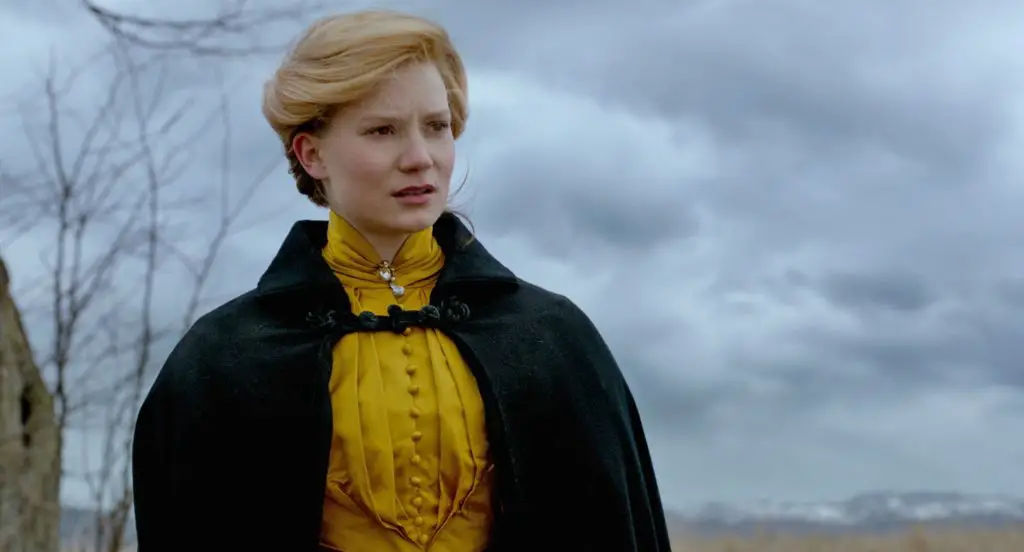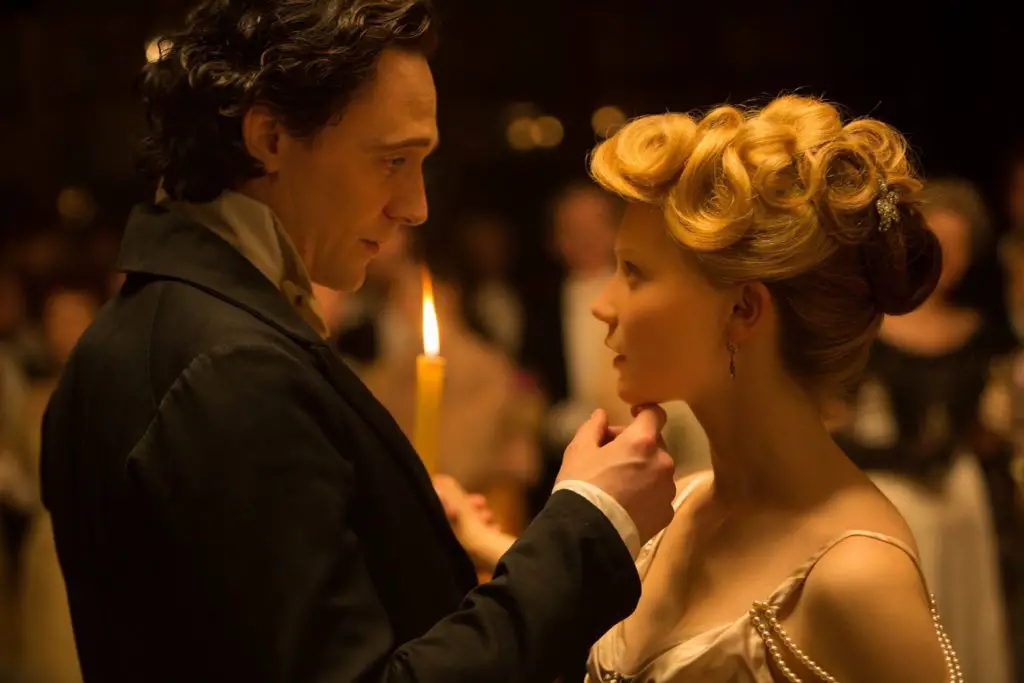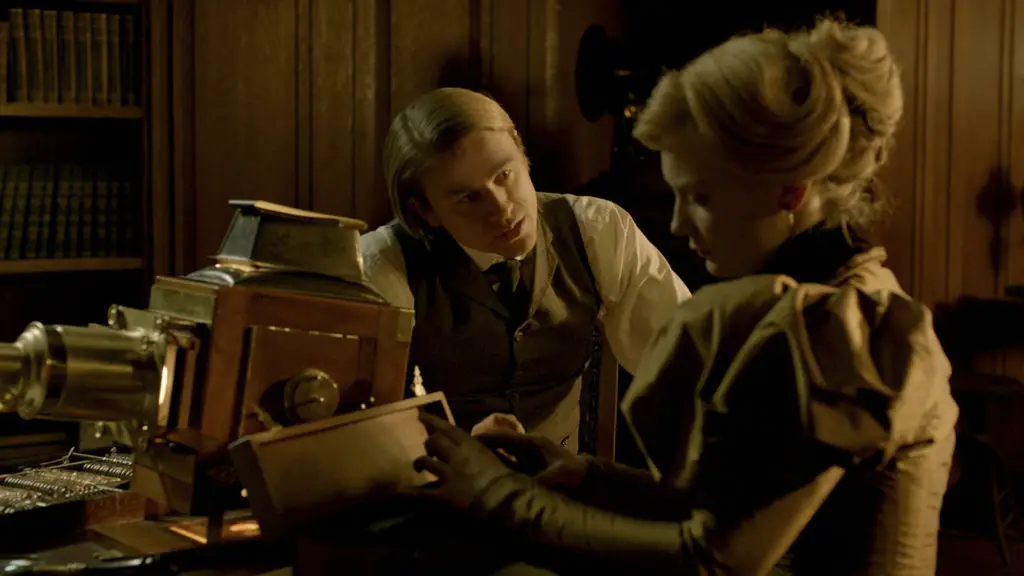Crimson Peak (2015): Plot, Meaning, Explanation Of The Ending, Similar Films. Bluebeard, Carl Gustav Jung, the decline of Europe and other meanings of the thriller “Crimson Peak”
Country: USA, Canada
Genre: Thriller, Drama, Detective, Film adaptation
Year of production: 2015
Directed by: Guillermo del Toro
Actors: Mia Wasikowska, Jessica Chastain, Tom Hiddleston
tagline: “Beware”
“Crimson Peak” is an experimental film from the recognized master Guillermo Del Toro: here the eminent director preferred to abandon the innovative parallel dramaturgy.
This is a beautiful psychological drama about love, jealousy and death. This is a movie about an unhappy childhood and about monsters. The meaning of the film “Crimson Peak” (Crimson Peak) is that not ghosts, but people are scary in all their forms: it was they who scared Stephen King’s “King of Horrors” here.
What is the movie about
The content of the film “Crimson Peak”. Young Edith believes in ghosts since childhood – from the moment her mother died of a terrible disease.
 Mia Wasikowska as American Edith Cushing. Frame from the film.
Mia Wasikowska as American Edith Cushing. Frame from the film.
One night, during a thunderstorm, she could not sleep, and at some point at the end of the corridor she saw a black female figure. It was the ghost of her mother. The ghost lay down next to the girl and told her to beware of the crimson peak.
14 years later, Edith went to the publisher to offer him her manuscript. On the stairs she ran into her old friend Alan. The young man informed her of his desire to open his own medical practice.
The editor, after reading the manuscript, rejected it and suggested that Edith write romance novels, which terribly offended the girl. A little later, she met the young baronet and inventor Thomas Sharpe. He noticed the manuscript on the table and was very interested in it. The girl herself was very interested in an attractive baronet, and the sympathy was mutual.
One day, Sharpe invited Edith to a party with him. There the girl met the baronet’s sister, Lucille. After some time, Sharpe and Edith realized that they loved each other, and the baronet decided to propose to her. His plans were thwarted by the girl’s father, who recently got his hands on some dirt on him and Lucille. The indignant old man demanded that the Englishman leave his daughter alone. A few hours later, someone brutally murdered him in a hotel.
Sorrow for her father did not prevent Edith from accepting Sharpe’s proposal, and she went with him to his estate in England, where he lived with his sister.
 Tom Hiddleston as Sir Thomas Sharp, Mia Wasikowska as Edith. Frame from the film.
Tom Hiddleston as Sir Thomas Sharp, Mia Wasikowska as Edith. Frame from the film.
The estate frightened Edith, and these fears were not groundless: the girl soon became convinced that terrible ghosts also live in a gloomy house. One day, she learned from her husband that the estate was called Crimson Peak in the winter because of the red patches of clay (which Sharp often worked with) showing through the snow. But in fact, everything is somewhat different – the gloomy house kept much more terrible secrets.
Soon Edith found out that her beloved husband had already been married several times, but all his wives died under strange circumstances. A longtime friend of Edith Alan also found out about this. Convinced that Sharp had killed all his wives, he hurried to England to rescue her.
In the finale, he tried to take Edith away from the terrible estate, but unexpectedly encountered the fierce resistance of both Sharpes.
Ending explanation
Toward the end, it became known that Thomas Sharp is a monster involuntarily: all the crimes were planned by his sister, and he was more of an accomplice. It also turned out that the sister and brother were connected not only by kindred feelings – they had been lovers for many years.
Explanation of the ending: Thomas prevented Lucille’s attempt to kill Edith, for which he paid the price – the insane sister killed him. But he did not go to the afterlife – his ghost saved Edith, whom Sharp, as it turned out, sincerely loved. After all the horrors they endured, Edith and Alan left England.
The meaning of the Crimson Peak ending is probably that true love can change anyone, even a criminal who has a lot of bloody deeds on his account. Although, given del Toro’s tendency to “cover up” real human dirt and abomination with mystical horrors, such a conclusion is rather arbitrary. It is in the finale that one can draw a direct parallel with Bluebeard, and the conclusion suggests itself: even a loving maniac remains a monster. So Edith is really lucky.
The meaning of the film
“Crimson Peak” is a fairy tale for adults. The fairy tale is terrible, but, despite the stamped plot and the lack of hidden meaning, it is almost philosophical.
At its core, the film “Crimson Peak” very much resembles the stories so beloved by many of us that we read at night in childhood, despite the fear – the stories of Bluebeard and Beauty and the Beast.
And the point here is not even in overlapping, very ornate plots, but in the subtleties of genres. The meaning of such stories lies in the desire and desire to save the human that remains after the nightmarish acts committed unconsciously, and directs to the deep layers – in particular to a severe trauma received in childhood (hello to Carl Gustav Jung) – and then to the collapse of personality.
“Crimson Peak” is a film-turn: from a sharp spire of terrible heights, the heroes have to descend to the roots of self-discovery. And these roots are dark, gloomy, but they have been through suffering – real and conscious.
The picture lacks both completely positive characters and their strict antipodes. Instead, there are only outlines – masks, shells. Del Toro is sure that these shells will be filled with an intangible substance that creates their appearance, only as a result of a conscious choice.
What will this look be like? Monstrous or human? It all depends on what steps the heroes took – towards terrible ghosts, or in spite of their own demons.
Crimson Peak is a gothic tale. The picture is also somewhat reminiscent of Jane Austen’s books, although the romantic line is not the main one here. The film has two distinct themes.
 The role of Lady Lucille Sharp was played by Jessica Chastain, Tom Hiddleston played the role of her brother, Thomas Sharp. Frame from the film.
The role of Lady Lucille Sharp was played by Jessica Chastain, Tom Hiddleston played the role of her brother, Thomas Sharp. Frame from the film.
Mother Theme
In general, the theme of the mother runs like a red thread through all the work of del Toro. The master himself had a very difficult relationship with his parent, which he somehow mentioned in an interview. Literally, he said the following: “Parents pass on their problems to children, those to their children, and so on ad infinitum. My picture is also about it.”
In Crimson Peak, the Sharpes’ mother is both a monster and a victim at the same time. When Thomas and Lucille were children, she and her husband consciously shielded them from their peers, and at the same time pushed them away from themselves with their coldness.
As a result, the children found the love and support they needed so much in each other. When they grew up, this love took on ugly, nightmarish forms, but is it really their fault?
The theme of the opposition of America and Europe
Del Toro loves to play with colors very much – this is the “trick” of all his paintings. It is the color that helps the master to explain to the viewer the meaning of his creations.
In Crimson Peak, the idea of contrasts comes to the fore. America is shown sunny, joyful, England – gloomy, blood-black, gloomy. In America, we see spacious, bright houses, in England – eerie castles, where a skeleton sits in each closet. In America, the cult of progress reigns, and in England, the inhabitants of gloomy estates are almost engaged in alchemy.
The heroes of the picture are also shown in contrast: the golden-haired American Edith courageously confronts the gloomy, two-faced Sharps. And luxurious dresses and intricate hairstyles are opposed to the chaos of a crumbling house.
The viewer clearly captures the message: America is the future, and old Europe is the past.
 Charlie Hunnam played the role of Dr. Alan McMichael. Frame from the film.
Charlie Hunnam played the role of Dr. Alan McMichael. Frame from the film.
Similar films
Here are a few paintings similar in meaning to “Crimson Peak”:
- “Dracula” (UK USA, 1992). Young Jonathan Harker arrives in Romania to meet an earl who wishes to purchase property in England;
- “Giorgino” (France, 1994). Early 20th century. A young doctor arrives at the orphanage where he grew up and encounters a nightmarish legend of the area come to life;
- “Gaslight” (USA, 1944). Paula marries for great love, and leaves with her husband to his estate. But family life is not going well: at some point, the girl begins to think that she is going crazy.







